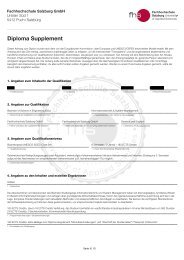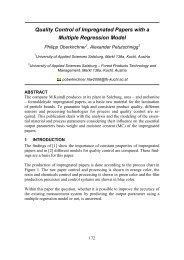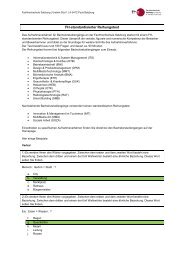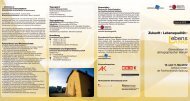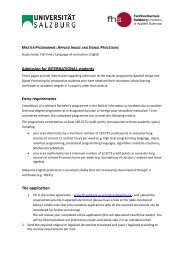Tannin-boron wood preservatives.
Tannin-boron wood preservatives.
Tannin-boron wood preservatives.
Create successful ePaper yourself
Turn your PDF publications into a flip-book with our unique Google optimized e-Paper software.
8<br />
CIMAD 11 – 1º Congresso Ibero-LatinoAmericano da Madeira na Construção, 7-9/06/2011, Coimbra, PORTUGAL<br />
with tannins. When the exposition is longer (3 min) the flame penetrated deeper into the sample<br />
and especially for pine this imply a longer ember time.<br />
It has to be reported that especially in the case of beech samples, the hardened tannin resin<br />
modifies the elasticity of the structure. When treated beech is undergone for a long time (>3<br />
minutes) to a flame it has the tendency to suddenly breake up.<br />
The use of inorganic compounds in the formulation increases the fire resistance properties of the<br />
samples. Particular activity is pointed out for the complete extinguish of the sample which becomes<br />
at least twice faster.<br />
This flame retardant action of tannin-furanic copolymer was already known (Tondi et al, 2009).<br />
The fire properties of tannin-hexamine copolymers have never been tested before and these<br />
preliminary tests can suggest some interesting information, also for the <strong>wood</strong> composite industry.<br />
The tannin-<strong>boron</strong> combination, which has already shown very good properties in <strong>wood</strong><br />
preservation, seems to be really interesting also for its flame retardant properties.<br />
4. Conclusions<br />
<strong>Tannin</strong> <strong>boron</strong> <strong>wood</strong> <strong>preservatives</strong> kept the attention of the scientific community for their<br />
impressive properties as fungicide for beech samples. The follow up of this project was to extend<br />
these features to other <strong>wood</strong> species and to study in deep which were the side-properties of this<br />
treatment.<br />
In this work it has been seen that this technology can be applied to scots pine working with more<br />
diluted solutions and taking care of the anatomic characteristics to avoid low penetration.<br />
Mechanical tests have shown that for beech and scots pine, the treatment increases the<br />
compression resistance and hardness of the samples.<br />
Treated beech samples can improve their mechanical properties up to 15% in compression<br />
resistance and up to 50% in hardness with solutions containing 20% of tannin.<br />
For scots pine the best improvements are achieved when 10% tannin solutions are applied. In<br />
these samples, compression resistance increases of 35% while hardness increases of around<br />
25%.<br />
Impregnated <strong>wood</strong> samples exposed to direct flame have shown to be much more fire resistant.<br />
Once the <strong>wood</strong> samples are treated with tannin, the ignition time becomes much longer and the<br />
flame extinguish time much shorter. The use of <strong>boron</strong> and phosphoric acid then break down the<br />
embers time and complete the characteristics of this fire resistant formulation.<br />
All these considerations keep the interest open for the up-scaling of this technology based on<br />
tannin-<strong>boron</strong> synergies.<br />
Before extending this promising technology to a semi-industrial scale, more virulent biological tests<br />
(e.g. termites), stronger condition leaching tests and artificial ageing tests are planned.<br />
Acknowledgements<br />
The authors wish to thank the support of FWF “Lise Meitner” project n.1232-B16.<br />
Bibliographic References<br />
Byrne, A.; Morris, P.I. (1997). “Recent research in <strong>boron</strong> treatment of canadian <strong>wood</strong> species”. 2°<br />
International Conference on Wood Protection with Diffusible Preservatives and Pesticides. Forests<br />
Products Society. 55–61.<br />
Grace, J.K.; Yamamoto, R.T. (1994). “Simulation of remedial borate treatments intended to reduce<br />
attack on Douglas-fir lumber by the Formosan subterranean termites (Isoptera: Rhinotermitidae)”.<br />
Journal of Economic Entomology. 87(6).1547–1554.




